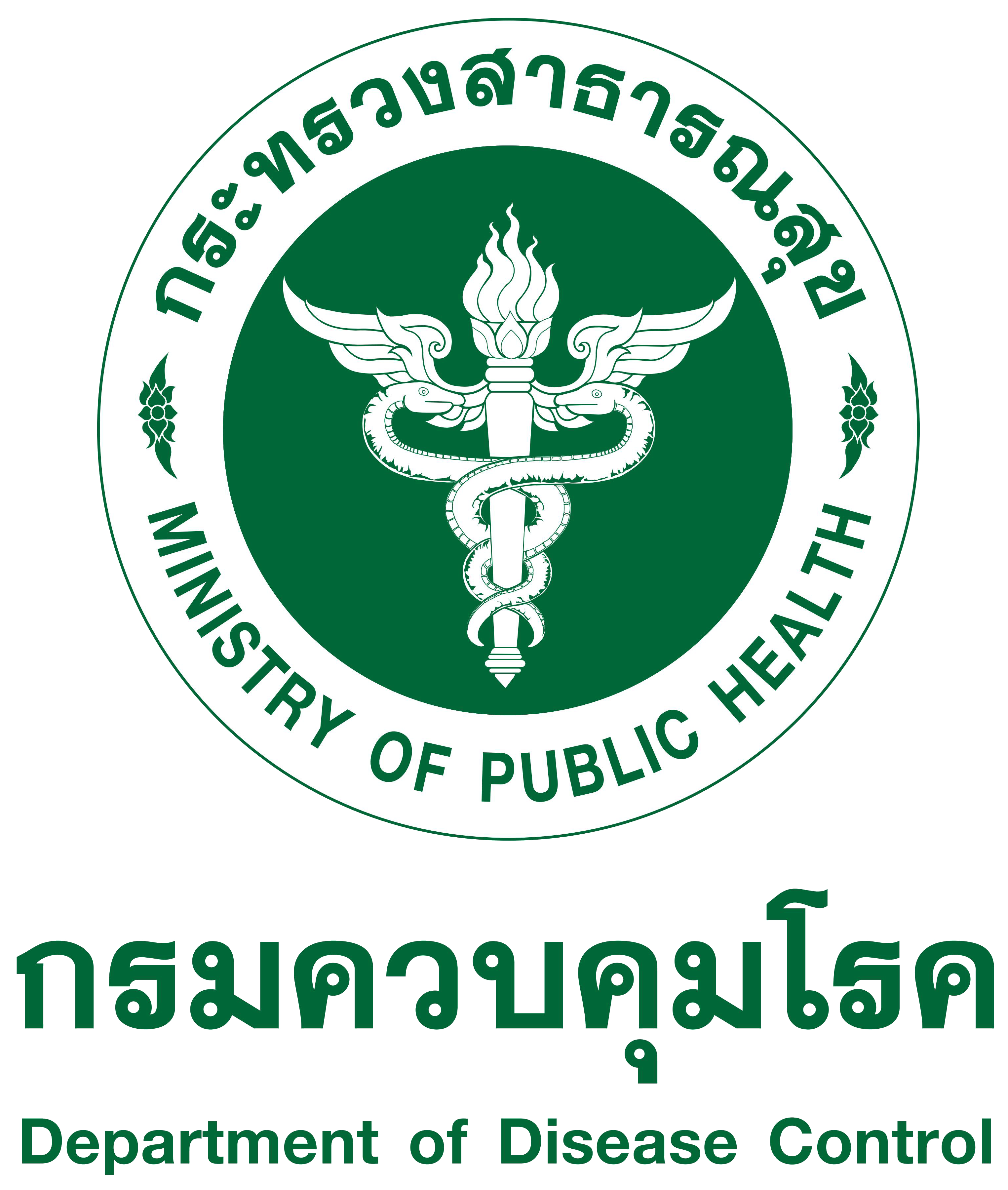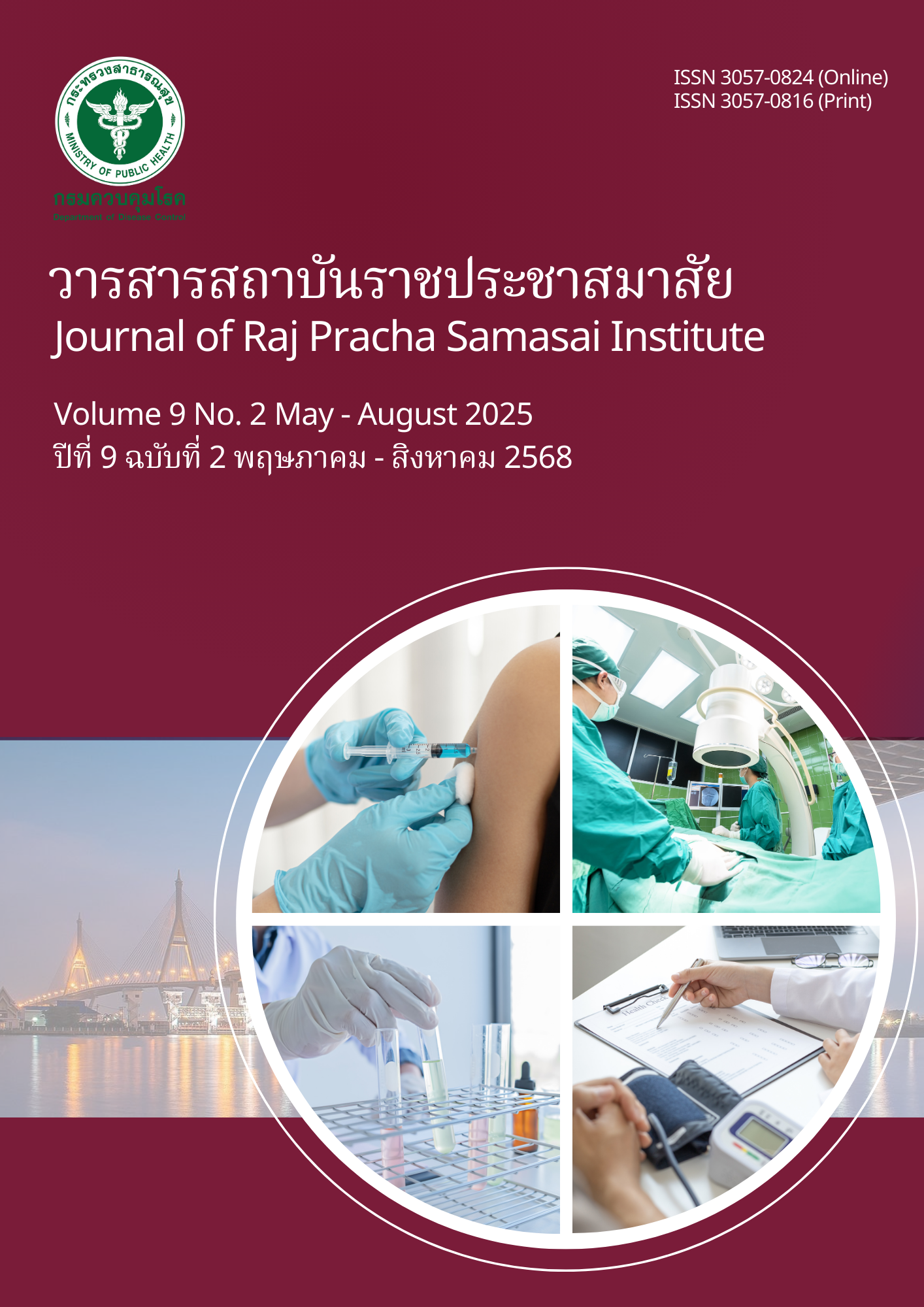ปัจจัยที่มีความสัมพันธ์กับการเกิดภาวะปอดอักเสบที่สัมพันธ์กับการใช้เครื่องช่วยหายใจ ของผู้ป่วยที่เข้ารับการรักษาในหอผู้ป่วยหนัก
Main Article Content
บทคัดย่อ
การวิจัยครั้งนี้เป็นการศึกษาเชิงพรรณนาแบบย้อนหลัง เพื่อศึกษาปัจจัยที่มีความสัมพันธ์กับการเกิดภาวะปอดอักเสบที่สัมพันธ์กับการใช้เครื่องช่วยหายใจ จำนวน 338 แฟ้ม คัดเลือกกลุ่มตัวอย่างแบบเจาะจงตามเกณฑ์ที่กำหนด เครื่องมือที่ใช้รวบรวมข้อมูล ได้แก่ แบบบันทึกข้อมูลที่ผู้วิจัยพัฒนาขึ้น ตรวจสอบคุณภาพโดยตรวจสอบความถูกต้องของเนื้อหาโดยผู้ทรงคุณวุฒิ และทดลองใช้บันทึกข้อมูลผู้ป่วย วิเคราะห์ข้อมูลด้วยสถิติเชิงพรรณนา ได้แก่ ร้อยละ และวิเคราะห์ความสัมพันธ์ด้วยสถิติ Chi-square Test ผลการศึกษาพบว่า มีอุบัติการณ์เกิดภาวะปอดอักเสบในผู้ป่วยที่ใช้เครื่องช่วยหายใจ ร้อยละ 20.28 โดยพบว่า ปัจจัย 7 ตัว มีความสัมพันธ์กับการเกิดภาวะปอดอักเสบของผู้ป่วยที่ใช้เครื่องช่วยหายใจอย่างมีนัยสำคัญทางสถิติ (p-value <.05) ได้แก่ ภาวะติดเชื้อในกระแสเลือด ประวัติการสูบบุหรี่ ประวัติการใช้ยากลุ่ม Clindamycin ประวัติการใส่ท่อช่วยหายใจซํ้า ระยะเวลาในการใช้เครื่องช่วยหายใจ ระยะเวลานอนหอผู้ป่วยวิกฤต และระยะเวลานอนโรงพยาบาล ดังนั้นควรเน้นการเฝ้าระวังและดูแลตามแนวปฏิบัติอย่างเคร่งครัด เพื่อการป้องกันการเกิดภาวะปอดอักเสบที่สัมพันธ์กับการใช้เครื่องช่วยหายใจ รวมถึงมีการนิเทศกำกับการปฏิบัติงานอย่างต่อเนื่อง และสร้างสิ่งแวดล้อมที่เอื้ออำนวยต่อการป้องกันการติดเชื้อ
Downloads
Article Details

อนุญาตภายใต้เงื่อนไข Creative Commons Attribution-NonCommercial-NoDerivatives 4.0 International License.
ประกาศเกี่ยวกับลิขสิทธิ์
บทความที่ลงพิมพ์ในวารสารสถาบันราชประชาสมาสัย ถือว่าเป็นผลงานทางวิชาการหรือการวิจัย และวิเคราะห์ตลอดจนเป็นความเห็นส่วนตัวของผู้นิพนธ์ ไม่ใช่ความเห็นกองบรรณาธิการแต่ประการใด ผู้นิพนธ์จำต้องรับผิดชอบต่อบทความของตน
นโยบายส่วนบุคคล
ชื่อและที่อยู่อีเมลที่ระบุในวารสารสถาบันราชประชาสมาสัย จะถูกใช้เพื่อวัตถุประสงค์ตามที่ระบุไว้ ในวารสารเท่านั้น และจะไม่ถูกนำไปใช้สำหรับวัตถุประสงค์อื่น หรือต่อบุคคลอื่นใด
เอกสารอ้างอิง
World Health Organization. Members States Information Session on Infection Prevention and Control (IPC). Geneva: World Health Organization; 2022.
Russo PL, Stewardson AJ, Cheng AC, Bucknall T, Mitchell BG. The prevalence of healthcare associated infections among adult inpatients at nineteen large Australian acute-care public hospitals: a point prevalence survey. Antimicrobe Resist Infect Control. 2019;8:114.
Department of Disease Control (TH), Bamrasnaradura Infectious Diseases Institute. Hospital Infection Diagnosis Manual. 1st ed. Nonthaburi: Bamrasnaradura Infectious Diseases Institute; 2018. (in Thai)
Department of Disease Control (TH), Bamrasnaradura Infectious Diseases Institute. National hospital infection rate report 2022. Nonthaburi: Bamrasnaradura Infectious Diseases Institute; 2022. (in Thai)
Somsorn S. Results of hospital infection surveillance in Health Region 4, year 2022. Journal of Science and Technology for the Community. 2023;1(5):45-56. (in Thai)
Central Chest Institute of Thailand (TH), Nursing department for infection prevention and control. Report of hospital infections in 2023. Nonthaburi: Central Chest Institute Of Thailand; 2023. (in Thai)
National Action Plan Group: Prevention and Control of Infectious Diseases and Antimicrobial Resistance in Hospitals. National Strategic Action Plan for Prevention and Control of Infections in Hospitals, 5-Year Period (2023 - 2027). 1st ed. Bangkok: Aksorn Graphic and Design Publishing; 2022. (in Thai)
Zhao D, Yao F, Wang L, Zheng L, Gao Y, Ye J, Guo F, Zhao H, Gao R. A comparative study on the clinical features of COVID-19 pneumonia to other pneumonias. Clinical Infectious Diseases. 2020;71(15):756-761.
Luo W, Xing R, Wang C. The effect of ventilator-associated pneumonia on the prognosis of intensive care unit patients within 90 days and 180 days. BMC Infectious Diseases. 2021;21:684.
Charles PGP, Wolfe R, Whitby M, Fine MJ, Fuller AJ, Grayson ML. SMART-COP: A Tool for Predicting the Need for Intensive Respiratory or Vasopressor Support in Community- Acquired Pneumonia. Clinical Infectious Diseases. 2014;47:375-84.
Shah H, Ali A, Patel AA, Abbagoni V, Goswami R, Kumar A, Botero FV, Otite E, Tomar H, Desai M, Maiyani P, Devani H, Siddiqui F, Muddassir S. Trends and Factors Associated with Ventilator-Associated Pneumonia: A National Perspective. Cureus. 2022;14(3):e23634.
Fang WF, Fang YT, Huang CH, Chen YM, Chang YC, Lin CY, Hung KY, Chang YT, Chen HC, Huang KT, Chang HC, Chen YC, Wang YH, Wang CC, Lin MC. Risk factors and associated outcomes of ventilator-associated events developed in 28 days among sepsis patients admitted to intensive care unit. Scientific Reports. 2020;10:12702.
Kózka M, Sega A, Gruszka KW, Tarnawska A, Gniadek A. Risk Factors of Pneumonia Associated with Mechanical Ventilation. International Journal of Environmental Research and Public Health. 2020;17:656.
Li Y, Liu C, Xiao W, Song T, Wang S. Incidence, Risk Factors, and Outcomes of Ventilator- Associated Pneumonia in Traumatic Brain Injury: A Meta-analysis. Nature and Neurocritical Care Society. 2020;32:272-85.
Shamsizadeh M, Jouzdani AF, Rahimi-Bashar F. Incidence and Risk Factors of Ventilator- Associated Pneumonia among Patients with Delirium in the Intensive Care Unit: A Prospective Observational Study. Critical Care Research and Practice. 2020;4826933:6.
Rattana P. Factors Related to Incidence of Ventilator-Associated Pneumonia at Hua Hin Hospital, Prachuap Khiri Khan Province. Journal of Research for Health Improvement 2023;3(1):37-48. (in Thai)
Chaiyakhot J. Factors Associated with Hospital-acquired Pneumonia and Ventilator-associated Pneumonia. Medical Journal of Sisaket Surin Buriram Hospitals 2022;37(1):171-81. (in Thai)
Unrit K. Factors Associated with Ventilator - Associated Pneumonia in Pediatric Intensive Care Unit, Mahasarakham Hospital. Mahasarakham Hospital Journal 2020;17(2):13-25. (in Thai)
Seubniam S, Ruaisungnoen W, Saensom D. Factors Associated with Early-onset Ventilator-associated Pneumonia Development among Critically Ill Medical Patients. Journal of Nursing and Health Care 2017;35(1);137-45. (in Thai)
Department of Disease Control (TH), Bamrasnaradura Infectious Diseases Institute. Updating IPC for Thailand 2024. 1st ed. Bangkok: Aksorn Graphic and Design Publishing; 2024. (in Thai)
Núñez SA, Roveda G, Zárate MS, Emmerich M, Verón MT. Ventilator-associated pneumonia in patients on prolonged mechanical ventilation: description, risk factors for mortality, and performance of the SOFA score. Jornal Brasileiro de Pneumologia. 2021;47(3):e20200569.
Krejcie RV, Morgan DW. Determining sample size for research activities. Educational and Psychological Measurement. 1970;30(3):607-10.
Papazian L, Klompas M, Luyt CE. Ventilator-associated pneumonia in adults: a narrative review. Intensive Care Medicine. 2020;46(5):888-906.
Sopori M. Effects of cigarette smoke on the immune system. Nature Reviews Immunology. 2002;2(5):372-377.
Patel AM, Periasamy H, Mokale SN. Immunomodulatory dose of Clindamycin in combination with ceftriaxone improves survival and prevents organ damage in murine polymicrobial sepsis. Naunyn-Schmiedeberg's Archives of Pharmacology. 2020;393(9):1671-1679.
Gattinoni L, Tonetti T, Cressoni M, Cadringher P, Herrmann P, Moerer O, Quintel M. Ventilator-related causes of lung injury: the mechanical power. Intensive Care Medicine. 2016;42(10):1567-1575.
Vincent JL, Rello J, Marshall J, Silva E, Anzueto A, Martin CD, EPIC II Group of Investigators. International study of the prevalence and outcomes of infection in intensive care units. JAMA. 2009;302(21):2323-2329.
Chastre J, Fagon JY. Ventilator-associated pneumonia. American Journal of Respiratory and Critical Care Medicine. 2002;165(7):867-903.
Hunter JD. Ventilator-associated pneumonia. BMJ. 2012;344:e3325.


